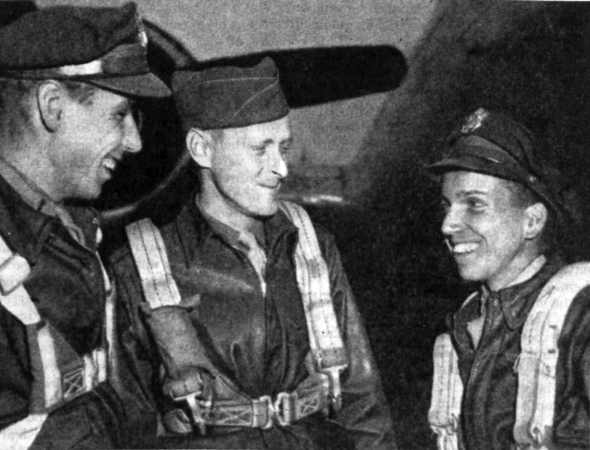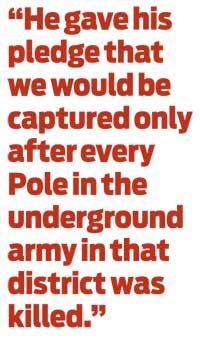Behind Enemy Lines

For years, American soldiers had heard about the courageous fight the Polish underground was waging against Nazi invaders in their native land. The stories became legend. But the fact that a highly organized Polish army battled daily at the back of the Wehrmacht never really crystallized, never came alive for U.S. soldiers, until the following story emerged in The Saturday Evening Post.
LONDON December 30, 1944 — “We took off at dawn on June 21, 1944, bombed our target in Germany and proceeded toward Russia,” said Lt. Louis R. Hernandez, 23, pilot of the downed bomber, as he began the narrative of the mission. “As we headed for Brest Litovsk, we saw four Messerschmitt 109s dart out of the clouds. Four more fighters came out of the same cloud bank and attacked us with fury, poking a huge hole in the wing between the Number One and Number Two engines. This caused the ship to plunge into a sudden dive. I promptly rang the alarm bell — the signal to bail out. I don’t remember anything after that until I regained consciousness in a rye field near a farmhouse. Three young Polish girls were holding me in their arms, trying to carry me.”
The plane’s engineer, Sergeant Anthony R. Hutchinson, 32, picked up the story: “When I landed, several men dressed like American farmers were coming toward me. I hollered, ‘American, America!’ They replied, ‘Comrade, comrade!’ They hugged me and kissed me. I was rushed to the nearest farmhouse where I was served up with scrambled eggs, black bread, cheese, and a very thick, sweet honey wine. I was very nervous. I didn’t feel much like eating, for fear the Germans were close by. But the Poles urged me to eat. They rolled cigarettes for me. When I got through gulping the food down, I asked, ‘Where are the nearest Russian troops?’ They indicated, with gestures, that the Russians were still some distance away.
“About this time, several girls carried Lt. Hernandez into the same house. He had been cut and was bleeding about the face. The girls washed and bandaged his cuts. He said it was best to get out of this spot as soon as possible, since our plane had crashed about 100 yards away and many people seemed to be gathering in the vicinity. The farmers bundled us in blankets and carried us out to a patch of tall grain. They indicated that we should lie there and wait.”
The two fliers lay there about a half hour when a 40-year-old man appeared on a bicycle.
“It sure was a relief to hear him speak English,” Hutchinson continued. “He identified himself as ‘Liniowiec,’ which I learned later means ‘Dreadnaught.’ He told us he was the quartermaster officer for this unit of the 34th Infantry Regiment, Polish underground army. Before the war, he had been a wealthy owner of a chain of movie houses in Warsaw.
“Dreadnaught said the Germans were already searching for us and that we had better leave with him quickly. A horse and wagon seemed to appear like magic. An underground doctor dressed Hernandez’s wounds after we got into the wagon. We stopped to change horses and wagons twice, but we always kept close to the forest. When we finally got to a village where some underground troops were quartered, to our delight, five others of our crew appeared.”
The reunited airmen soon met the district underground leader in an obscure farmhouse near the forest. Dreadnaught introduced the man as Commander Zenon. “He spoke to us that first night. With Dreadnaught as interpreter,” recalled Lt. Alfred R. Lea, 25, the plane’s navigator. “He gave his pledge that we would be captured by the Germans only after every Pole in the underground-army unit assigned in that district was killed.”
In the early hours of June 23, orders were issued to move out of the hideout. The airmen were placed in a horse-drawn cart, while 200 resistance fighters, some on horses and others on bicycles, deployed around them as escort. The troopers carried heavy water-cooled machine guns, German-made rifles and machine pistols and grenades.
“We traveled until 8 a.m. — some five hours,” Lea said. “The Poles moved without fear, since they knew the whereabouts of German troops all the time. They impressed us as a genuine military organization and as well disciplined as any unit in the field.”
For the next week, Zenon’s followers and the airmen moved from village to village, always by night, and hid by day. On June 30, the underground troops had their first battle with the Germans.
“We had started to eat when a dispatch rider on a bicycle gave us our first alarm,” remembers Hutchinson. We made a dash for the nearest rye field, hugging the ground. The Gestapo fired at us as Zenon, Dreadnaught, and two Polish troopers joined our party. Zenon then jumped up to give us cover and with his tommy gun — a German Spandau — fired several volleys. Both Lea and I saw him kill four Germans. A fifth tumbled down. The rest beat a hasty retreat.This respite gave us time to find better concealment. We dashed through a potato field into a nearby forest and waited. All the Polish troops assembled here, too, as if by a prearranged signal. The Germans returned — about 500 of them. A pitched battle took place, with the 200 Poles defending us. The Germans, armed with light field guns, machine guns, and one tank, encircled us. They were firing point-blank into the wooded area. The fight lasted for five hours before the Germans retreated, leaving 48 killed and many wounded.”
On July 4 came one of the biggest surprises for the seven airmen. Hutchinson said, “We got up early and found the 300 troops polishing their guns and boots, cleaning their uniforms and scrubbing down their horses. They kept this up for about six hours. We asked what it was all about, but got no satisfactory reply. Finally, Zenon called us to a makeshift reviewing stand. Through Dreadnaught, he explained they were helping us celebrate American Independence Day and added, ‘Come, watch the parade.’ The whole show lasted five minutes, including a short speech by Zenon. Dreadnaught translated the speech to us later. Zenon said that Poland is seeking the same kind of independence that America was enjoying.
 “That parade made a lasting impression on all of us. They were just trying to give us a little hunk of home — and to do it, they risked surprise by the Germans, always nearby.”
“That parade made a lasting impression on all of us. They were just trying to give us a little hunk of home — and to do it, they risked surprise by the Germans, always nearby.”
They spent seven days in hiding. During the next nine days, the band moved through as many villages. All the time, they could see German aircraft overhead. Several more times, they fought skirmishes with the Germans, and the American Airmen took part in the fighting.
The new Russian offensive, which started on June 24, was moving westward across Poland swiftly. The Germans were suffering catastrophic losses as they retreated. The American airmen could hear clearly the booming of heavy artillery from the direction of the Russian front on July 24.
“Soviet relief arrived late in the afternoon of July 27,” Lea said. “[At Soviet field HQ, where the airmen were taken on the 28th,] there took place the oddest transaction we Americans ever experienced. The Russian colonel made out a receipt for ‘delivery of seven American airmen’ to him, signed the receipt, turned the original over to Zenon and kept the duplicate. Then each of us had to sign the same receipt in duplicate, to confirm the delivery, adding our serial numbers. Zenon said he would deliver the receipt to the Polish underground HQ in Warsaw. Zenon stayed with us for another day, leaving Dreadnaught with us to the end. We surely hated to see Zenon go. But, on July 29, early, he came to us, said he was departing and saluted. We tried to tell him how much we owed to him, but he merely replied, ‘It was my duty. We all fight for the same end, comrades all.’
“Our last day in Poland was on July 30. Dreadnaught remained with us until, from a secret airbase, we flew to an American field in Russia. Dreadnaught exchanged salutes, shook hands, and we left. We saw him standing there. He seemed dejected. I know we were.”
In the debriefing that followed, the airmen marveled at the thorough efficiency of the underground organization and its ingenious methods in resisting and thwarting the Germans. The seven concluded their story by saying: “If we worked all our lives for the Poles, regardless of the dangers and hazards involved, we should never be able to repay what they did for us.”
— Excerpted from “Seven Fighting Guests of the Polish Underground,” December 30, 1944
Accompanying pieces from the July/August 2015 issue:
“The World War II Struggle That Time Forgot” by Michael Luongo
“Freedom Fighters” by Michael Luongo